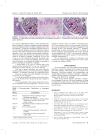Heterotopic Gastric Mucosa in the Distal Part of Esophagus in a Teenager: Case Report
- PMID: 26496283
- PMCID: PMC4620775
- DOI: 10.1097/MD.0000000000001722
Heterotopic Gastric Mucosa in the Distal Part of Esophagus in a Teenager: Case Report
Abstract
Heterotopic gastric mucosa (HGM) of the esophagus is a congenital anomaly consisting of ectopic gastric mucosa. It may be connected with disorders of the upper gastrointestinal tract, exacerbated by Helicobacter pylori. The diagnosis of HGM is confirmed via endoscopy with biopsy. Histopathology provides the definitive diagnosis by demonstrating gastric mucosa adjacent to normal esophageal mucosa. HGM located in the distal esophagus needs differentiation from Barrett's esophagus. Barrett's esophagus is a well-known premalignant injury for adenocarcinoma of the esophagus. Malignant progression of HGM occurs in a stepwise pattern, following the metaplasia-dysplasia-adenocarcinoma sequence.We present a rare case of a teenage girl with HGM located in the distal esophagus, associated with chronic gastritis and biliary duodenogastric reflux. Endoscopy combined with biopsies is a mandatory method in clinical evaluation of metaplastic and nonmetaplastic changes within HGM of the esophagus.
Conflict of interest statement
The authors have no funding and conflicts of interest to disclose.
Figures



References
-
- Tang P, McKinley MJ, Sporrer M, et al. Inlet patch: prevalence, histologic type, and association with oesophagitis, Barrett oesophagus, and antritis. Arch Path Lab Med 2004; 128:444–447. - PubMed
-
- Chong VH. Pascu O. Heterotopic gastric mucosal patch of the proximal oesophagus. Gastrointestinal Endoscopy. Croatia: InTech Publishing; 2011. 125–148.
-
- Von Rahden BH, Stein HJ, Becker K, et al. Heterotopic gastric mucosa of the esophagus: literature-review and proposal of a clinicopathologic classification. Am J Gastroenterol 2004; 99:543–551. - PubMed
-
- Tanpowpong P, Katz AJ. Heterotopic gastric mucosa causing significant esophageal stricture in a 14-year-old child. Dis Esophagus 2011; 24:E32–E34. - PubMed
Publication types
MeSH terms
LinkOut - more resources
Full Text Sources
Medical

